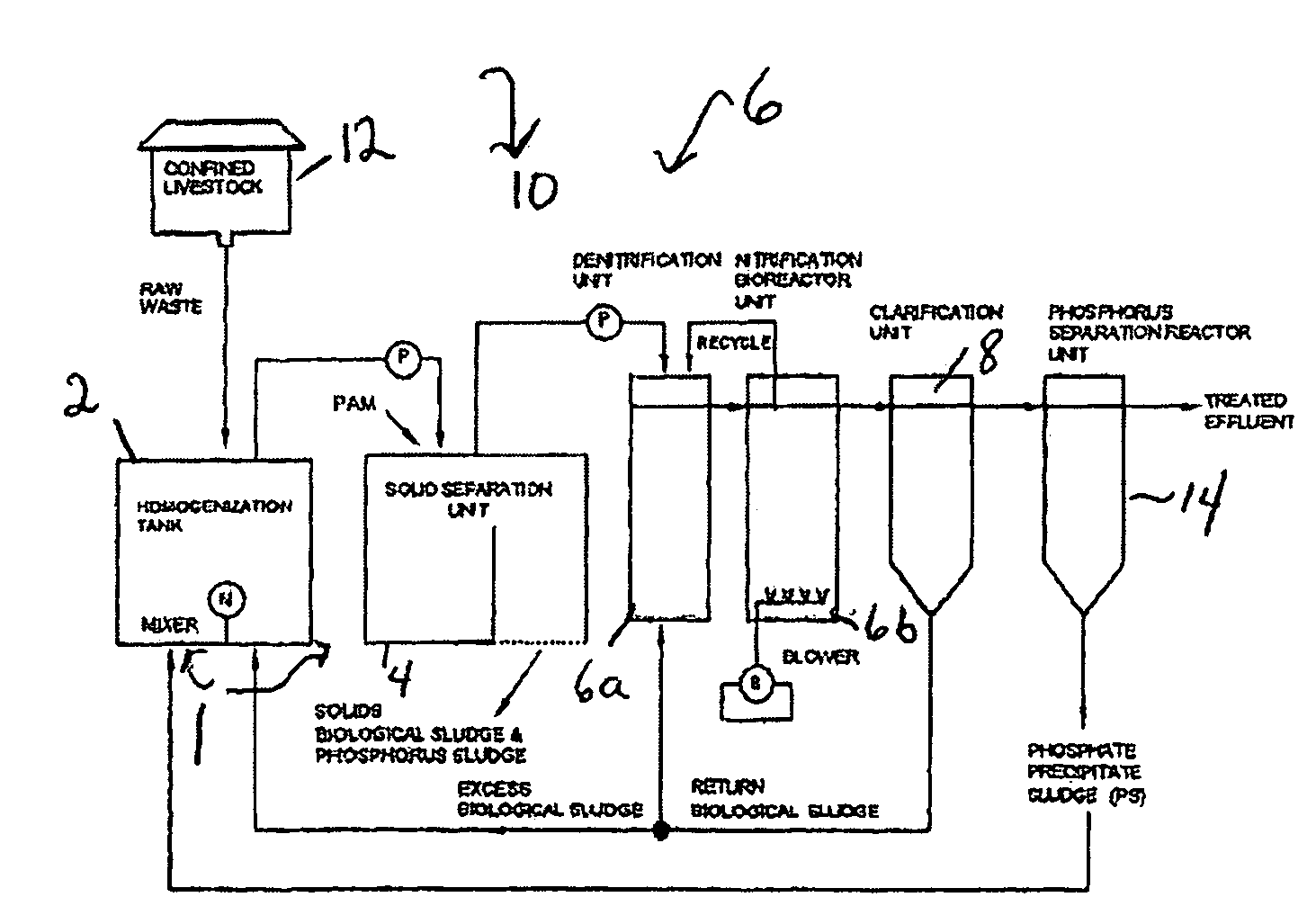Wastewater treatment system with simultaneous separation of phosphorus and manure solids
a technology of wastewater treatment system and manure solids, applied in the direction of multi-stage water/sewage treatment, separation process, filtration separation, etc., can solve the problems of lack of functional and sustainable treatment system, large urban and agricultural waste disposal, and high density of animals
- Summary
- Abstract
- Description
- Claims
- Application Information
AI Technical Summary
Benefits of technology
Problems solved by technology
Method used
Image
Examples
example 1
[0041]Flushed raw swine manure (SM) and phosphorus sludge (PS) used in all of the examples were collected from a homogenization tank and the phosphorus separation unit, respectively, from a system as described in U.S. Pat. No. 6,893,567, supra and shown in FIG. 1a with the plant operating at steady state. Swine manure samples were collected immediately after flushing about 136 m3 of manure from three barns into the homogenization tank. An existing submergible mixer (3.5 kW, 12.1 m3 / min, ABS Pumps, Inc., Meriden, Conn.) kept the manure well mixed during the sampling. The swine manure samples were taken from mid-height of the homogenization tank using plastic tubing connected to a peristaltic pump sampler (Sigma 900, American Sigma, Inc., Medina, N.Y.), and collected in 20-liter plastic containers. The phosphorus sludge samples were taken from the bottom of the settling tank of the phosphate removal unit (FIG. 1a) using existing manual valves, and also collected in 20-liter plastic co...
example 2
[0043]To evaluate the possible re-dissolution of phosphorus sludge when mixed with raw swine manure, PAM addition and screening were not performed. Phosphorus sludge was mixed with raw swine manure at a rate of approximately 33 ml / L and the mixture was continuously stirred at about 60 rpm during a 24 hour period using a 6-unit programmable jar tester (model PB-900, Phipps & Bird, Inc., Richmond, Va.) The rate of approximately 33 ml of phosphorus sludge per liter of swine manure is based on average flows of approximately 39 m3 / d for swine manure into the homogenization tank and approximately 26 m3 / d for liquid into a phosphorus reactor (Vanotti et al., 2005c), and a phosphorus sludge generation rate of about 50 ml / liter treated in the phosphorus reactor (Vanotti et al., 2003). Control was raw swine manure without phosphorus sludge addition. This experiment was replicated three times. Samples of approximately 30 ml were taken at about 0, 0.5, 1, 2, 3, 18, and 24 hours from the mixing ...
example 3
[0048]This example compared the performance of cationic (+), neutral (0), and anionic (−) PAMs for solid-liquid separation of swine manure / phosphorus sludge mixtures. The polymers employed were commercially available PAM formulations (Table 3). For cationic PAM, two types were evaluated: one with approximately 20% charge density and another with approximately 75% charge density. The PAM treatments were applied to the raw swine manure / phosphorus sludge mixture (approximately 33 ml of phosphorus sludge per liter of swine manure) using working solutions at a rate of approximately 60 mg active ingredient (a.i.) per liter. Working solutions of PAM were approximately 0.2% secondary solutions after preparation of approximately 0.5% primary stocks (WERF, 1993). The swine manure / phosphorus sludge and PAM were mixed for approximately 30 seconds and poured into a 0.25 mm screen to separate the mixture into its solid and liquid (filtrate) components. Treatment performance was determined by the ...
PUM
 Login to View More
Login to View More Abstract
Description
Claims
Application Information
 Login to View More
Login to View More - R&D
- Intellectual Property
- Life Sciences
- Materials
- Tech Scout
- Unparalleled Data Quality
- Higher Quality Content
- 60% Fewer Hallucinations
Browse by: Latest US Patents, China's latest patents, Technical Efficacy Thesaurus, Application Domain, Technology Topic, Popular Technical Reports.
© 2025 PatSnap. All rights reserved.Legal|Privacy policy|Modern Slavery Act Transparency Statement|Sitemap|About US| Contact US: help@patsnap.com



